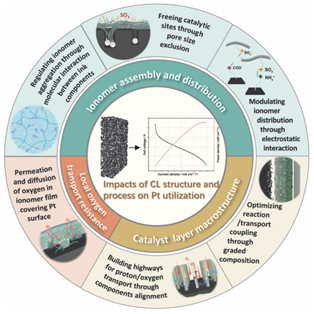It is essential to realize an expected low usage of platinum (Pt) in proton exchange membrane fuel cells (PEMFCs) for the large-scale market penetration of PEMFC-powered vehicles. As well as seeking Pt-based catalysts with a high specific activity, improving Pt utilization through structure optimization of the catalyst layer (CL) has been the main route and apparently a more practical way so far to develop high-performance low-Pt PEMFCs. Despite the significant progress achieved in the past 2–3 decades, a visible gap remains between the current Pt demand of automobile PEMFCs and the target value. To further increase Pt utilization, insights from previous studies are necessary. This review analyzes the structural factors that impact the current-generation efficiency of Pt in PEMFC electrodes in great detail, with emphasis particularly put on the mechanistic and molecule-level insights into the structural effects. The contents include the so-called local transport resistance associated with the permeation and diffusion of oxygen molecules in the ionomer film covering the Pt surface, regulation of ionomer aggregation through molecular interactions between ink components, modulation of ionomer distribution through pore size exclusion and surface electrostatic interaction of the carbon support, optimization of the coupling between the reaction and transport processes through graded composition, and the formation of highways of protons, electrons, and gas molecules through component alignment. We provide a critical analysis of the measurement methods and theoretical models assessing the local transport resistance, which is considered as a crucial issue in the current-generation efficiency of Pt in ultralow-Pt CL. Finally, new opportunities toward the further promotion of Pt utilization are proposed. These subjects and discussions should be of great significance in the rational design and precise fabrication of PEMFC electrodes, and may also inspire similar subjects in other electrochemical energy technologies such as water electrolysis, CO2 reduction, and batteries.
https://doi.org/10.1039/D1CS00981H
